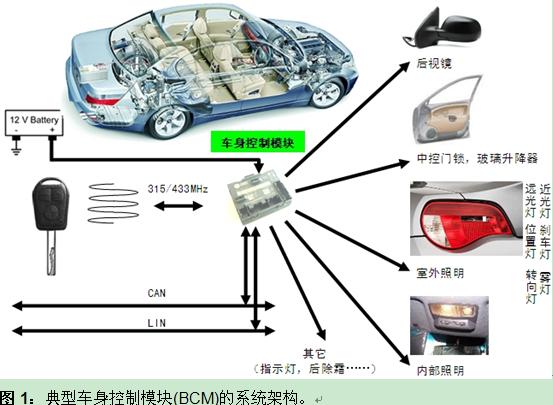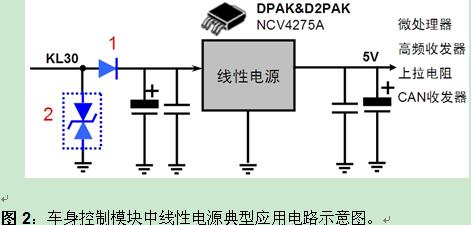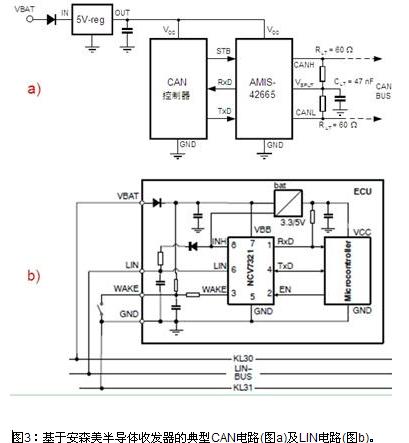ON Semiconductor body control module design requirements solutions
People's demand for car handling and comfort is increasing, and there are more and more electronic devices in the car body, such as electric rearview mirrors, central control door locks, glass lifters, car lights and even more advanced functions. . 
An important step in the design of a typical body control module (BCM) is to determine the power requirements and select the appropriate power solution. Generally speaking, the input voltage required by BCM is between -0.5 V and 32 V, and the output voltage is 5 V or 3.3 V. It is worth mentioning that there are more and more electrical equipment in the car. If the quiescent current of the equipment directly powered by the battery is not low enough, and the car is parked for a long time, the battery in the car may be unable to restart due to excessive discharge. Therefore, BCM design needs to consider quiescent current. In addition, automotive applications may often face high-temperature environments, so the power supply is required to provide over-temperature protection.
Power supplies suitable for BCM include linear power supplies (or linear regulators) and switching power supplies (or switching regulators). These two types of power supply have their own advantages, and the choice of power supply depends on the specific application. Regarding the power supply of the body control module, among cars sold on the Chinese market, cars generally use 12 V power supplies, while trucks and buses generally use 24 V power supplies. In the 12 V power supply BCM, it is recommended to use ON Semiconductor linear regulators, such as NCV4275A, see Figure 2. NCV4275A is a 5 V, 3.3 V / 450 mA low dropout (LDO) linear regulator with reset and delay function. This device supports programmable microcontroller reset and provides various features such as overcurrent protection, Over temperature protection, short circuit protection, etc. In addition, a diode (MRA4005) is connected in series at position 1 in the figure below. This linear power supply can effectively prevent reverse voltages up to -42 V; a parallel transient voltage suppressor (TVS) tube at position 2 can effectively prevent up to The +45 V transient power supply load dump high-voltage pulse and unstable power supply clutter meet the ISO16750-2-2003 4.6 overvoltage test specification of the 12 V automotive power supply system. In fact, a sudden load drop may occur at the moment of starting the car engine, which causes the battery voltage to rise to more than 40 V. These characteristics make NCV4275A very suitable for automotive body control module applications.
In fact, NCV4275A is only one of ON Semiconductor's wide range of linear regulators for automotive applications. Other linear regulators include NCV8664 / 5, NCV4949, NCV8503 / 4/5/6, NCV4274A, etc. Products with ultra-low quiescent power consumption have a quiescent current as low as 30 μA and a drive current range between 100 mA and 450 mA.
Power requirements and options

In the BCM application of the 24 V power supply, it is necessary to convert the 24 V voltage to 5 V or 3.3 V. If a linear regulator is used, the power chip itself will have a high power consumption, which generates a lot of heat and causes the temperature to be too high and burn out. Chip, so we need to use switching regulators, we recommend using ON Semiconductor's switching regulators for automobiles, such as NCV51411, NCV8842, NCV8843, NCV33063, NCV33163, NCV3063, NCV3163, LM2576, LM2575 and NCV2574. These switching regulators have high efficiency, avoid generating a lot of heat, protect the chip, and improve system reliability. The driving currents of switching regulators in these automotive applications are mostly between 0.5 A and 1.5 A, and some reach 2.5 A (NCV33163), and the switching frequency is between 50 kHz and 300 kHz. Taking NCV51441 as an example, this device uses a V2 control architecture to provide unmatched transient response, excellent overall voltage regulation accuracy, and the simplest loop compensation. The "BOOST" pin on this device supports "Bootstrapped" operation to maximize energy efficiency; the integrated synchronization circuit supports parallel power supply operation or minimizes noise.
Body network requirements and development trends
There are many types of system buses that can be used in automobiles, such as Controller Area Network (CAN), Local Interconnect Network (LIN), and FelxRay. The characteristics of these buses are different. Table 1 compares several common system buses in automotive applications and lists typical ON Semiconductor bus transceiver products.

ON Semiconductor's bus transceiver series is very suitable for body control network application requirements. Figures 3a) and b) show typical circuits based on ON Semiconductor's CAN transceiver AMIS-42665 and LIN transceiver NCV7321, respectively. It is worth mentioning that AMIS-42665 provides very low quiescent current of less than 10 μA. Support bus wake-up, common mode voltage range -35 V to +35 V, can withstand rated electrostatic discharge (ESD) pulses of +/- 8 kV. The NCV7321 supports a voltage range of -45 V to +45 V and withstands ESD pulses rated at 5 kV. These devices provide powerful protection functions.

In the application of body control network, it is necessary to cooperate as much as possible to reduce cost and space requirements, and at the same time improve the stability and long-term reliability of the system, so it is necessary to increase the integration of components. Thanks to the mixed-signal processes that have emerged in recent years, such as ON Semiconductor ’s Smart Power high-voltage BCD process, high-voltage analog circuits can now be integrated with low-voltage circuits, allowing higher-integration system chips to be developed and applied. For example, ONC's NCV7440 integrates a linear regulator and a CAN transceiver on the same chip, and NCV7420 integrates a linear regulator and a LIN transceiver. Such integration effectively saves space on the PCB board, can provide power to the MCU alone, and effectively restrains the interference of other modules on the MCU power supply.
ON Semiconductor, as the world's leading supplier of high-performance, high-reliability silicon solutions, has launched an ultra-highly integrated chip, NCV7462, for automotive body control network applications. This chip integrates a linear regulator, CAN transceiver, LIN transceiver, watchdog (WD) circuit, low-side drive and high-side drive, reducing the number of external components required to a minimum and occupying only a minimum Board space and help simplify the design process.
Design requirements and solutions for remote locking and unlocking
The application of remote locking and unlocking in automobiles is becoming more and more popular. The body control module uses 315 MHz (United States, Japan) or 433MHz (Europe) frequency to realize remote control locking and unlocking functions through high frequency reception and transmission. The design difficulty in this type of application is to design an impedance matching circuit to minimize power loss. Common requirements for such applications include low quiescent current, providing sleep mode, low transmit power, high receiving sensitivity, low power consumption, and suitable frequency range. ON Semiconductor ’s ON-53480 high-frequency transceiver meets these design requirements well. For example, the quiescent current is as low as less than 1 µA, with wake-up and sleep detection, the signal level is only 10 dBm, and the receiving sensitivity is even lower. At -100 dBm, and the operating current is only 10 mA, the frequency range is 280 to 343 MHz.
Off-board high-power load drive and scheme comparison
The body control module circuit board needs to provide power for some high-power loads outside the board. These loads include automotive interior lighting (5 W and 10 W), unidirectional motors, and car speakers. An optional solution is to use an on-board relay. The coil of the relay is an inductive load, and the inductive load needs a larger starting current than the current required to maintain normal operation when it is started, and the inductive load generates a back electromotive force at the moment of turning on or off the power. To drive the relay, ONU's NUD3124, NUD3160, or NCV7608 relay driver can be used.

Another solution is to use "pre-driver + MOSFET" to drive off-board high-power loads. The pre-driver can use ON Semiconductor's NCV7513A. This device supports parallel port and SPI port communication. And open circuit diagnosis function.
The third option is to use SmartFET drive. This is a MOSFET with protection. On the basis of the MOSFET, a variety of functions are added, such as overvoltage clamping, ESD protection, overcurrent protection, overtemperature protection, reverse voltage protection, and high-side and low-side driving. Typical devices are NCV8401 / 2/3 for low-side drive, and NCV8450 and NCV8460 for high-side drive (with integrated boost circuit inside). The advantages and disadvantages of these three schemes are shown in Table 2.
Other solutions applied to BCM
In addition to the high-power loads other than the above-mentioned boards, the common electric rearview mirrors in automotive applications can use ON Semiconductor's NCV7703 to drive the steering motor. This device provides three half-bridge outputs with an output current of 0.6 A up to 1 A. It has self-diagnostic functions and provides features such as low quiescent current, SPI communication, and low voltage / overvoltage / overtemperature protection.
In addition, the body control module needs to collect dozens of signals such as door, car lock, combination switch, etc., often need to expand the input port of the MCU, which requires a parallel port to serial port logic conversion chip, commonly used is ON Semiconductor 8 Bit shift register MC14021B.
ON Semiconductor also provides different solutions for combined tail lights. For example, NCV7680 is an 8-channel low-side constant-current driver, which can set the tail driving / braking current output in pulse width modulation (PWM) mode, while NSI45xx is a new constant-current linear regulator (CCR) based on Anson The patent pending self-biased transistor technology of American Semiconductor provides high performance with low cost and ruggedness. It focuses on replacing the resistive drivers used in some automotive taillights.
to sum up:
The body control module (BCM) with harsh application environment puts forward higher requirements for components. This article explores and discusses the requirements of BCM design in many aspects such as power supply, body network and off-board high-power load drive, and comparatively analyzes the advantages and disadvantages of different programs in some fields. ON Semiconductor is the world's leading supplier of high-performance, energy-efficient silicon solutions. It provides robust protection features, high reliability, and low quiescent current solutions for automotive applications such as body control modules, such as power regulators and buses. Transceivers, high-frequency transceivers, relay drivers, pre-drivers, motor drivers, LED drivers, and MOSFETs, etc., help designers to choose better component solutions for their BCM designs, and thus have an advantage in the market.
For lithium iron phosphate(LiFePO4) power battery system with brand of Taihang Jiaxin, it has the advantages of long cycle life, high rate of discharge performance, good safety, available for the requirement for Fast Charging and so on.
Using self-developed Battery Management System (BMS) which has the functions of advanced battery self-management, communication, alarm and other functions.

Lifepo4 Battery Pack,Lifepo4 Battery Pack 12V,24V Lifepo4 Battery Pack,48V Lifepo4 Battery Pack
Xinxiang Taihang Jiaxin Electric Tech Co., Ltd , https://www.chargers.be
